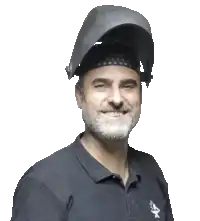Corten
Corten steel sheets tailored to suit your requirements
If you are looking for tailor-made sheet metal from corten steel, you are right with us! Here you will find our selection of Corten sheet metal blanks, which are always made according to your desired size.
Whether you use the sheets for artistic designer pieces in your own garden or build durable steel structures in the outside area, we are there for you. With our uncomplicated blank service, you can easily and accurately specify your dimensions in the online shop and order them directly. It's easier!
What is Corten steel?
Cortensteel is a weatherproof construction steel that comes out completely without painting or similar surface coatings, as it only rusts surface. As a result of weathering influences, a so-called barrier layer forms under the grate layer, which reliably protects the material from further corrosion.
The name Corten, or also Cor-Ten, is originally from English and stands for the "corrosion resistance" and "tensile strength", which translates into German "corrosion resistance" and "tensile strength" and thus represents an indication of the good material properties of the material.
In general, cortene is divided into two types which, although they are identical in corrosion resistance and tensile strength, are very different in terms of processing and optics.
Corten A
Corten A has the material number 1.8946 and is one of the phosphorus-alloyed construction steels. The phosphorus contained in the steel ensures a particularly uniform patina. The rusty surface is therefore particularly uniform and has few irregularities. Unfortunately, the phosphorus also ensures a relatively poor weldability and reshapability.
Corten B
Corten B carries the material number 1.8965 and does not contain any phosphorus content, thereby obtaining good weldability and reshaping.
Metal sheets in rust optics
Corten is known for its rustic noble pink look, which results from the appealing patina and comes particularly well in the outdoor area. Although a similar appearance can also be made with conventional sheets of DC01 or S235JR However, these materials cannot withstand the outstanding durability of corten. Who wants to have more of his sheets in rust optics, rely on Corten.
How long it takes for the grate and the barrier layer lying below it to be formed depends very strongly on the weather conditions. A rapid, steady change between wet and dry periods promotes rust formation, would sustained drought delay the formation of rust. In principle, however, it can be assumed that cortene in the outer area after approx. months completely covered with rust.
Hot or cold rolled? Where's the difference?
Sheets in general and thus of course also sheet metal from corten steel are available in two different designs which relate to the production type. In both cases, production in the steelworks begins with a thick steel block, the so-called billet. This is rolled out until a long sheet metal strip has been formed in the desired thickness of the material. In the case of hot-rolled sheets, this process takes place at extremely high temperatures, so that the final material thickness is still achieved in the annealing state. In cold-rolled sheets, this is different. Although these are initially also brought into the coarse form under heat, they only receive their final sheet thickness in the cooled state. The two processes each have advantages and disadvantages and have a strong influence on the material properties. However, we would like to take this into account and instead focus on the optical differences.
Cold-rolled sheets of corten steel
As a rule, most sheets with a sheet thickness below 3 mm are cold-rolled sheets. They have a smooth, clean and metallically shiny surface which later forms a particularly uniform grate layer. For this reason, these sheets are ideal for smaller designs and decorative items.
Hot-rolled sheets of corten steel
The hot-rolled sheets can be seen on their dark surface, the so-called blending layer, or also the rolling skin. It is produced due to the high temperatures in the production process and later ensures a very structured and uneven grate layer which is particularly well suited to larger areas. Of course, this optics is not everyone's thing. For this reason, there are roller skin removers with which the sheet metal surface can be cleaned in order to achieve a more uniform grate layer later.
Applications of Cortenbleche
Cortenstahl is particularly popular in bridge, container and ISO container construction due to its good properties. The material is also strongly represented in plant construction. Sheets from Corten are also used for sculptures and works of art. But also in architecture, Cortenbleche are enjoying increasing popularity and are used there mainly for facade design.

